
Title means "Quietness", "Comfortable Sound" and "Excellent Acoustics"
Nagata Acoustics News 06-05 (No.221)
Issued :May 25, 2006
Yamagata Prefectural Community Hall Renovation Project -
Asbestos Abatement, Seismic Retrofit and Acoustical Improvements
by Masaya Uchida
Renovated Interior of the Hall
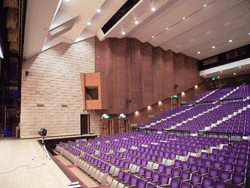 |
|
|
Original Interior of the Hall
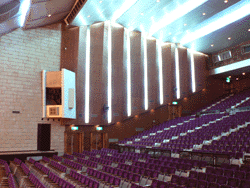 |
|
Yamagata Prefectural Community Hall, built in 1962 and accommodating an audience of up to 1,500 persons, is one of the major public halls of Yamagata City. Starting in November, 2005, the Prefectural Community Hall closed for a renovation project that primarily targeted asbestos abatement and seismic retrofit, reopening with a renewed look in April 2006. The renovation activities required for the project's primary goals included complete reconstruction of the hall's ceiling, so the client took advantage of this opportunity to make acoustical improvements to the hall by changing the hall ceiling from being a sound-absorbing surface to one that provides sound reflections back into the hall. Yamashita Sekkei Inc. designed the renovation project, Chitose Kensetsu served as the construction contractor, and Nagata Acoustics conducted the before-and-after acoustical evaluations, as well as providing room acoustical advice during the construction phase of the project.
<< The Community Hall's Pre-renovation Room Interior >>
Prior to the renovations, the community hall's interior was as follows: (1) the sidewalls at the right and left of the stage ware finished with Japan's distinctive Oyaishi stone fascia; (2) the sidewalls of the audience seating area had perforated composite paneling with a low ratio of openings to surface area; (3) the auditorium rear wall was perforated composite paneling with a high ratio of openings to surface area; (4) the ceiling front from the ceiling spot lights had a mortar finish; and, (5) the ceiling rear from the ceiling spot lights was covered with perforated aluminum sheets and sound-absorbing material. Thus, heavy-weight, sound-reflective material was arranged around the proscenium. By contrast, the audience seating area had, overall, a significantly stronger sound-absorbing characteristic compared with that of more recently built multipurpose halls.
The hall's reverberation time (at 500 Hz, with the hall unoccupied) measured 1.1 seconds when using the proscenium reflection panels and 1.0 seconds when configured with a stage curtain. As a result, the hall's reputation with orchestras and other performers of classical music was less than positive.
<< Changing the Hall Ceiling >>
While reverberation time is one of the most significant determinants of a hall's acoustical character or "personality," the distribution of early sound reflections in the hall is also critical, and the shape of a hall ceiling affects the distribution of early reflections greatly. Therefore, in designing the renovation of the community hall ceiling, once we made sure that we retained sufficient space for the existing above-ceiling ductwork and catwalk (since these items were not in scope for the project), we focused our efforts on creating a design that maximizes effective distribution of early sound reflections.
Specifically, for the transition of the ceiling area from the stage to the audience seating area, we changed the angle of the ceiling to rise steeply and for the upper portion to be angled toward the stage. This shape increases the propagation of sound reflections to the front sections of the audience seating area. At the rear of the auditorium, we also increased the ceiling surface area angled toward the stage so that abundant sound reflections reach the audience seating below.
<< Other Room Acoustical Design Changes >>
In selecting the finishes for the new ceiling, we began by considering the pluses and minuses of the pre-renovation hall's design, which used a sound-reflecting surface constructed with heavy mortar at the front portion of the ceiling. In the renovated hall design, for the front part of the ceiling, we used three layers of 6 mm. (0.2") fiber-reinforced gypsum board, plus a fourth layer of 12.5 mm (0.5") gypsum board. For the ceiling portion towards the rear of the hall, we used a layer of 9.5 mm. (0.37") gypsum board, plus a double layer of 12.5 mm. (0.5") gypsum board.
In addition to the changes to the ceiling, we also changed the surfaces around the sidewalls' slits for indirect lighting and the surfaces around the front side of the lighting control room. Both of these hall elements were sound-absorbing before the renovation and sound-reflecting in the renovated hall.
<< Results of the Acoustical Renovations >>
Post-renovation measurements of the hall's reverberation time reveal an increase to 1.5 seconds (at 500 Hz, with the hall unoccupied) when the proscenium sound-reflection panels are in place and a reverberation time of 1.3 seconds when using the stage curtain. The accompanying Figure 1 depicts the hall's reverberation time characteristic by frequency before and after the renovation, measured with the proscenium sound-reflection panels deployed. These reverberation times still cannot be said to pass muster for the performance of classical music, but, nevertheless, the new measurements do provide satisfying reverberation time levels for the typical uses of multipurpose halls.
Figure 2 shows the sound pressure level distribution (at 2,000 Hz) of a constant sound, measured before and after the renovation, at audience seats located along a line at the center of the hall. As can be seen in the graph, the sound reflections produced by the renovated ceiling increased the sound pressure level by 2.5 dB - 5 dB for the audience seating starting at row 11 and continuing to the rear of the auditorium, and the variance improved from 10 dB to 6 dB. We also measured corresponding improvements along other lines of seats.
Fig.1 Hall's reverberation time
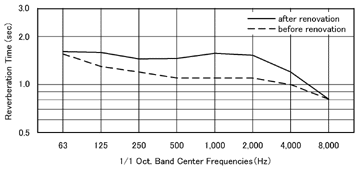 |
|
| | | | | |
Fig.2 Hall's sound pressure level distribution
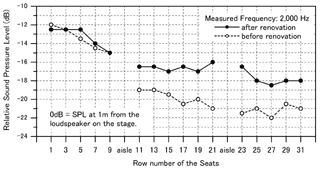 |
|
<< The Yamagata Symphony Orchestra Plays in the Renovated Hall >>
I have not yet had the pleasure of hearing a concert in the renovated hall, but the Yamagata Symphony Orchestra recently played its regularly scheduled subscription concert there and the hall received favorable reviews from both the players and the audience. Unlike the pre-renovation hall, which had a somewhat dingy and dark appearance, the renovated hall presents a cheery and bright atmosphere that makes the space seem to be an entirely different hall than before, and the previously overlooked purple upholstery of the audience seating now creates a memorable impression.
The hall's administrators have expressed their satisfaction with the new acoustics and the new interior appearance, saying that the changes will enable them to use the hall for at least another 10 years. The renovation project breathed new life into this hall that will, hopefully, be reflected in a revitalized schedule of events.
Sound Isolation Design Part 2 of a Series:
Isolating the Sound of Japanese Taiko Really Is Difficult!
by Toshiko Fukuchi
Taiko (Japanese Drums) Performance
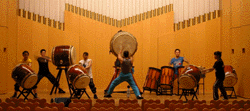 |
Japanese taiko are enjoying a renaissance in Japan. Along with the instrument's increase in popularity, hall planners and sponsors, now ask if their plans will make a future hall usable as a venue for taiko performances, or if their recently completed hall can be used for taiko concerts. Their question refers to the sound isolation capabilities of their halls vis-a-vis the sound generated by taiko drumming. From an acoustical design perspective, sound isolation of taiko drumming is, in fact, one of the most difficult of all sound isolation challenges.
Recent trends in Japanese concert hall design include building multiple music practice rooms into a single facility in order to support the musical activities of the local community. Another trend is combining several halls of different audience sizes under one roof. In buildings with these kinds of multiple rooms, we typically isolate sound between practice rooms and the hall, or between halls, by setting the same rigorous sound isolation standards used for recording studio sound isolation, and by implementing the most effective anti-vibration structural design measures. Nevertheless, even when we implement the most comprehensive sound isolation structural design, if the sound to be isolated is taiko drumming, it is extremely difficult to reduce the sound transfer to a level of complete inaudibility. For example, in my experience, when we combine all of our most often employed sound isolation measures and techniques to ensure optimal sound isolation, including creating physical distance between the sound-source room and the receiving room, building both rooms using vibration and sound-isolating structures and placing expansion joints between the rooms, we find that our efforts, at best, only reduce the transfer of taiko sound to a level that it is no longer an impediment to using the receiving room.
<< The Special Acoustical Characteristics of Taiko Drumming >>
SPL measurement of
Japanese Drums Performance
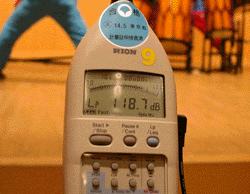 |
The essence of the Japanese taiko cannot be fully grasped apart from Japanese "matsuri" ("festivals"). In this author's hometown of Kitakyushu City, Gion Matsuri is an annual event that takes place in early summer, and its stalwart taiko drumming is immortalized in the 1958 movie "Muhomatsu no Issho" (known in English by the title "Muhomatsu, the Rickshaw Man"). Before a Japanese festival starts, the taiko drumming begins and can be heard through the town or neighborhood. The taiko's sound fills the air and builds excitement among the crowd in advance of the parade of people, portable shrines, dancers and other participants in the festival parade.
The more skilled the taiko drummer, the sharper and more crisp the attack produced by the "bachi" drumsticks, and the more the drumming sound carries across far distances. In addition to the taiko's large sound volume, the sharp, crisp sound of the attack adds to the acoustician's difficulty in isolating the taiko's sound from penetrating to spaces beyond the performance or practice room.
As shown in Figure 3, at its loudest, the sound pressure level of taiko drumming reaches 120 dB. Some people may associate very loud music with rock music bands, yet rock music output levels typically do not exceed 110 dB, so the sound of the Japanese taiko often matches or exceeds that of the loudest rock band. Certainly, the decibels a taiko drummer produces depends on drumming technique and skill. For the taiko instrument, the more advanced and virtuoso the technique, the louder the drumming becomes. Also, the sound frequency characteristics of the taiko depend on the instrument's size, so that the larger the diameter of the top of the taiko, the lower will be the peak frequency of the instrument's range. A 1 shaku 6 sun (48 cm./18.9") taiko has a peak frequency of 125 Hz, and a 2 shaku (60 cm./24") taiko's peak frequency is 63 Hz. As for taiko drums larger than 3 shaku (90.9 cm/36.8") that are used in concerts by professional artists such as Eitetsu Hayashi and Kodo (www.kodo.or.jp/frame.html), the sound frequency ranges these instruments produce can be expected to skew towards even lower tones. To summarize, low register sound comprises an extremely large portion of the sound frequency characteristics of the sound taiko drums produce.
Fig.3 SPL of Japanese Drums Performance
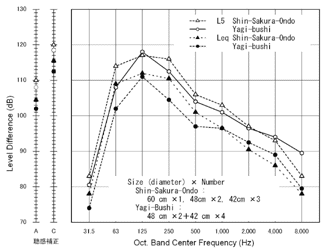 |
|
| | | | | |
Fig.4 SPL in Receiving Room
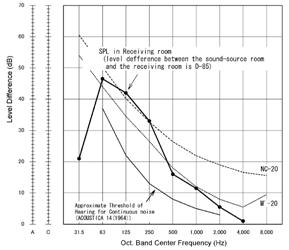 |
|
<< Taiko Drumming and the Propagation of Sound to a Receiving Room >>
The sound isolation performance of building materials generally tends to be less strong at lower frequencies and to exhibit improved sound isolation performance characteristics the higher the sound frequency to be isolated. Accordingly, compared with mid-range and high frequency sound, low-frequency sounds are more difficult to isolate.
Figure 4 shows the level of sound that can be heard in a receiving room, when the sound isolation performance between the receiving room and the sound-source room is D-85, and the instrument played in the sound-source room is a taiko. (The "D" rating is a Japanese standard for measuring sound isolation performance.) Figure 4 also shows the NC rating (NC-20) and the masking threshold level (M ' -20), as well as the curve of the threshold of hearing for continues noise
The NC curve represents the well-known noise criteria value, used to assess the noise level in a room. A rating of NC-20 is the generally recognized level of noise acceptable in concert halls, and a room with an NC-20 rating is considered to have achieved a satisfyingly high degree of quietness.
The M ' curve represents a value called the masking threshold level. This value represents the threshold below which the human ear does not hear a sound due to the presence of another sound. That is, the presence of the one sound hides, or "masks" the other sound, preventing it from being audible.
According to standards set by the Architectural Institute of Japan, a D-85 sound isolation rating requires sound isolation performance of the following combinations of frequency and decibel: 125 Hz/70 dB, 250 Hz/78 dB, 500-4‚‹Hz/85 dB. The standard does not specify the acceptable decibel level for 63 Hz and below, however the values of 31.5 Hz/21 dB and 63 Hz/47 dB can be posited based on the 125 Hz and 250 Hz decibel values.
Obtaining the robust sound isolation performance level of D-85 requires that both the sound-source room and the receiving room be constructed with vibration and sound isolating structural designs. In the hypothetical room situation exhibiting the NC and M ' values depicted in Figure 4, even if we adopt vibration and sound isolating structural designs for both the sound-source room and the receiving room, the taiko drum sound exceeds the M ' -20 values in the 63-250 Hz range, and will therefore pass through the masking threshold and be audible to the human ear in the receiving room. In practice, if sound isolation performance of D-85 can be achieved for frequencies of 125 Hz, then a high level of sound isolation performance can also be attained for frequencies of 250 Hz, so that the frequencies that pass through the sound isolation barriers are limited to 63 Hz and 125 Hz. The perceived effect is a subtle, rhythmic "dom, dom, dom" sound heard as the "bachi" drumsticks repeatedly strike the taiko drum.
<< Scheduling Taiko Drumming and Other Music at the Same Time >>
The answer to the question of whether it is possible to have a taiko drum performance or practice session at the same time that other musical events are taking place in a hall is, in a word, no. Certainly, if the noise level in the sound-receiving room is very loud or the sound produced by the event in the sound-receiving room is very loud, or if the receiving room musicians are practicing and can tolerate extraneous sound passing into the room, then simultaneous use of a facility by taiko drummers and other music performers is possible. For the most part, however, the wise approach is to avoid overlapping taiko drumming performance and practice schedules with performances in other rooms of a single facility. In particular, since classical music concerts require an exceptionally quiet environment, simultaneous use of a building for a taiko drum concert and classical music concert should absolutely be avoided.
In summary, the acoustical room design techniques for achieving maximum sound isolation include, first, physical separation of multiple rooms, as well as the use of expansion joints implemented for acoustical effectiveness and the adoption of vibration and sound-isolating structural designs. However, even when all of these techniques are robustly implemented in combination, the honest position of the acoustical consultant must be that it is not possible to guarantee the complete sound isolation of taiko drumming. When the acoustical design includes all possible measures for optimal sound isolation and the construction team executes the design plans to perfection, the hall must still apply a judicious approach to scheduling programming in order to eliminate all chance of a complaint about taiko drumming noise interfering with another program or performance. The key to harmonious use of multipurpose facilities by taiko drummers and other musicians rests with the people who operate the facilities.
This article presents the unique acoustical characteristics of the taiko drum instrument and the caution that must be exercised when arranging taiko drum practice and performance times and venues. The increased popularity for this traditional art form is surely a welcome phenomenon, and taiko musicians of all skill levels deserve access to space where they can play enthusiastically, but we should also recognize that the nature of this unique instrument presents a challenge to multipurpose cultural centers and other buildings striving to meet the needs of entire communities.
E-mail Distribution of Nagata Acoustics News & Opinions
We hope you have enjoyed this News & Opinions newsletter, available each month on our web-site (http://www.nagata.co.jp). We also offer e-mail delivery of the text version of this newsletter. To receive the text newsletter to your e-mail address, simply send the following information to us at newsmail_e@nagata.co.jp:
(1) Your e-mail address
(2) Your name
(3) The name of your company
By requesting the text version via e-mail, you will automatically receive every newsletter and you can still get the visuals and graphics at our web-site.
Nagata Acoustics News 06-05 (No.221)
Issued : May 25, 2006
Nagata Acoustics Inc.
Hongo Segawa Bldg. 3F, 2-35-10
Hongo, Bunkyo-ku, Tokyo 113-0033 Japan
Tel: +81-3-5800-2671, Fax: +81-3-5800-2672
(US Office)
2130 Sawtelle Blvd., Suite 307A,
Los Angeles, CA 90025, U.S.A.
Telephone: (310) 231-7818
Fax: (310) 231-7816
E-mail: info@nagata.co.jp




